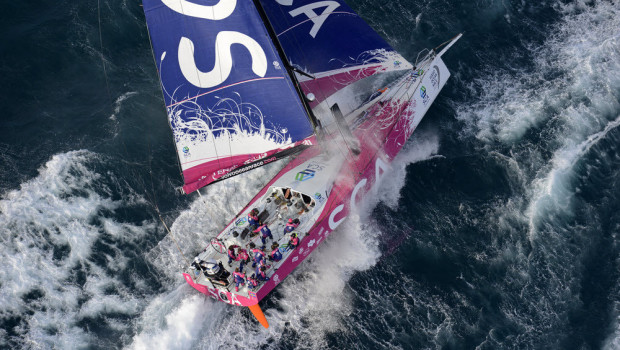Full menu of variables for Volvo Ocean Race fleet
Published on November 19th, 2014
(November 19, 2014; Day 1) – The second leg of the Volvo Ocean Race got underway in what may stand up as the most entertaining start of the 2014-15 edition.
As the shadow of Table Mountain played havoc with the conditions, varying winds from near nothing to upwards of 35 knots, spectators witnessed lead changes and on-edge performance for the seven teams as they navigated an inshore 5-leg course before departing on the 6,125 nm course from Cape Town to Abu Dhabi.
An appropriate beginning for what lies ahead. “We will have Southern Ocean, Doldrums, pirates, Persian Gulf – we have a big month ahead of us,” commented Sam Davies, Team SCA’s skipper.
While some teams exhibited caution at the start, careful of breaking battens or tearing sails, MAPRE would have none of it. The Spanish boat, with two new crew members, and so much to prove after finishing last of the Leg 1 finishers, were quickest out of the block and raced to the opening marks in near gale-force winds.
Soon enough, though, the fleet bunched up in a lull to see Team SCA take a turn in the front. Team Brunel, however, soon found the better pressure and took the honors to lead the fleet out of Cape Town bay and out towards the Southern Ocean, followed closely by MAPFRE and then Team SCA.
As the teams sought to get clear of the land affects, a few more shuffles in the standings now finds the fleet on a southeasterly course, sailing near close hauled as they work their way around the bottom of South Africa before considering their northerly course up the Indian Ocean.
“We’re expecting a pretty heinous sea state,” said 30-year-old American skipper Charlie Enright of Team Alvimedica. “The first two nights are going to be difficult to manage. The breeze is up for the first night, then the breeze drops off for the day and picks up again as we cross the Agulhas Current on the second night.”
The Agulhas Current is the western boundary current of the south-west Indian Ocean. Flowing down the east coast of Africa, it is narrow, swift and strong.
“The three strongest Western boundary currents in the world are the Gulf Stream off the Eastern coast of the USA, the East Australian current off Australia, and the Agulhas Current off the east coast of Africa,” explained Alvimedica navigator Will Oxley. “We can see 4, even 5 knots, flowing towards the south, and the wind is coming from the south. So that creates standing waves. The current is only about 80 miles wide at the moment, but it’s still boat-breaking conditions – we have to be careful of that.”
If there was good news, at this point it seems like the winds might not be as bad as first expected… for now.
Leg 2 Position Report (as of 21:40 UTC)
1. Team Alvimedica, Charlie Enright (USA), 5152 nm Distance to Finish
2. Team Vestas Wind, Chris Nicholson (AUS), 0.8 nm Distance to Lead
3. Dongfeng Race Team, Charles Caudrelier (FRA), 3.5 nm DTL
4. Abu Dhabi Ocean Racing, Ian Walker (GBR), 4.9 nm DTL
5. MAPFRE, Iker Martinez (ESP), 5.4 nm DTL
6. Team SCA, Sam Davies (GBR), 7.0 DTL
7. Team Brunel, Bouwe Bekking (NED), 7.2 nm DTL
Race website – Tracking – Watch log – Videos
Background: The 2014-15 Volvo Ocean Race began in Alicante, Spain on Oct. 11 with the final finish on June 27 in Gothenburg, Sweden. Racing the new one design Volvo Ocean 65, seven teams will be scoring points in 9 offshore legs to determine the overall Volvo Ocean Race winner. Additionally, the teams will compete in 10 In-Port races at each stopover for a separate competition – the Volvo Ocean Race In-Port Series. The second offshore leg from Cape Town, SA to Abu Dhabi, UAE is 6,125 nm, starting Nov. 19 with an ETA of Dec. 9-19.









 We’ll keep your information safe.
We’ll keep your information safe.